jump start SUBARU FORESTER 2007 SG / 2.G Owners Manual
[x] Cancel search | Manufacturer: SUBARU, Model Year: 2007, Model line: FORESTER, Model: SUBARU FORESTER 2007 SG / 2.GPages: 356, PDF Size: 5.89 MB
Page 123 of 356
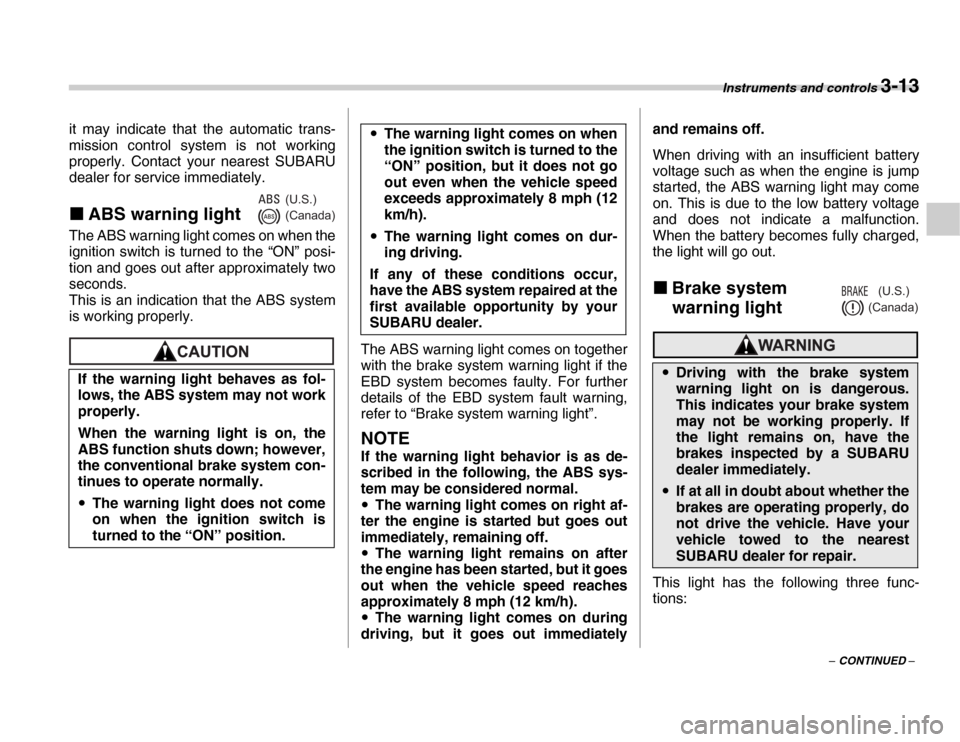
Instruments and controls 3-13
– CONTINUED –
it may indicate that the automatic trans-
mission control system is not working
properly. Contact your nearest SUBARU
dealer for service immediately. �„
ABS warning light
The ABS warning light comes on when the
ignition switch is turned to the “ON” posi-
tion and goes out after approximately two
seconds.
This is an indication that the ABS system
is working properly.
The ABS warning light comes on together
with the brake system warning light if the
EBD system becomes faulty. For further
details of the EBD system fault warning,
refer to “Brake system warning light”.
NOTE
If the warning light behavior is as de-
scribed in the following, the ABS sys-
tem may be considered normal. �y The warning light comes on right af-
ter the engine is started but goes out
immediately, remaining off. �y The warning light remains on after
the engine has been started, but it goes
out when the vehicle speed reaches
approximately 8 mph (12 km/h). �y The warning light comes on during
driving, but it goes out immediately and remains off.
When driving with an insufficient battery
voltage such as when the engine is jump
started, the ABS warning light may come
on. This is due to the low battery voltage
and does not indicate a malfunction.
When the battery becomes fully charged,
the light will go out. �„
Brake system
warning light
This light has the following three func-
tions:
If the warning light behaves as fol-
lows, the ABS system may not work
properly.
When the warning light is on, the
ABS function shuts down; however,
the conventional brake system con-
tinues to operate normally. �y
The warning light does not come
on when the ignition switch is
turned to the “ON” position.
(U.S.) (Canada)
�yThe warning light comes on when
the ignition switch is turned to the
“ON” position, but it does not go
out even when the vehicle speed
exceeds approximately 8 mph (12
km/h).
�y The warning light comes on dur-
ing driving.
If any of these conditions occur,
have the ABS system repaired at the
first available opportunity by your
SUBARU dealer.
�y Driving with the brake system
warning light on is dangerous.
This indicates your brake system
may not be working properly. If
the light remains on, have the
brakes inspected by a SUBARU
dealer immediately.
�yIf at all in doubt about whether the
brakes are operating properly, do
not drive the vehicle. Have your
vehicle towed to the nearest
SUBARU dealer for repair.
(U.S.) (Canada)
Page 208 of 356
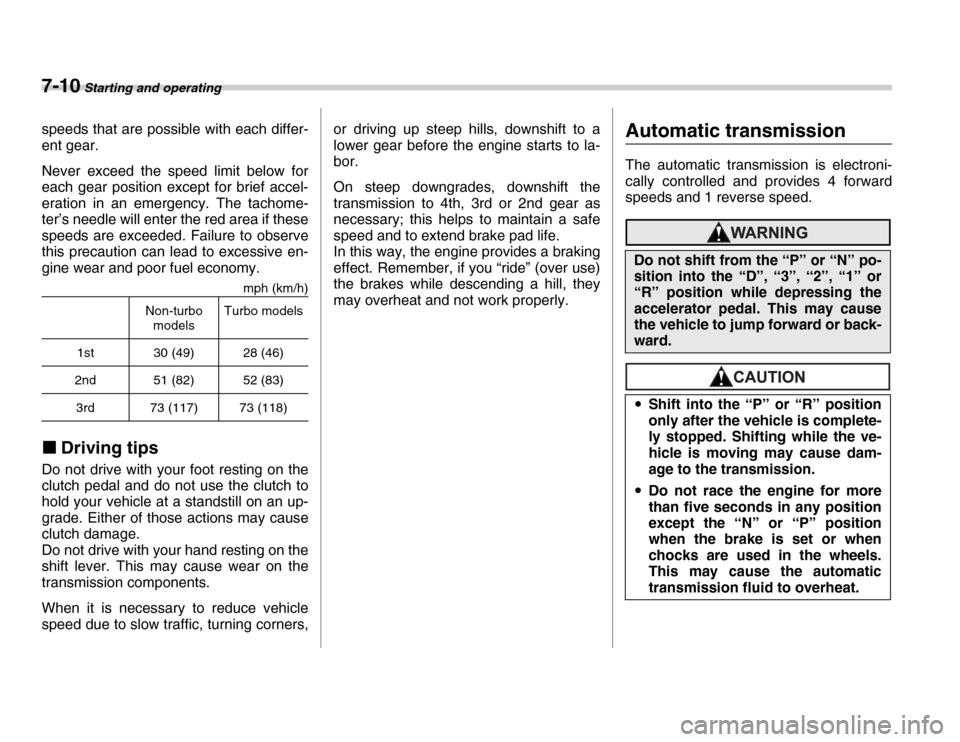
7-10 Starting and operating
speeds that are possible with each differ-
ent gear.
Never exceed the speed limit below for
each gear position except for brief accel-
eration in an emergency. The tachome-
ter’s needle will enter the red area if these
speeds are exceeded. Failure to observe
this precaution can lead to excessive en-
gine wear and poor fuel economy.mph (km/h)
�„ Driving tips
Do not drive with your foot resting on the
clutch pedal and do not use the clutch to
hold your vehicle at a standstill on an up-
grade. Either of those actions may cause
clutch damage.
Do not drive with your hand resting on the
shift lever. This may cause wear on the
transmission components.
When it is necessary to reduce vehicle
speed due to slow traffic, turning corners, or driving up steep hills, downshift to a
lower gear before the engine starts to la- bor.
On steep downgrades, downshift the
transmission to 4th, 3rd or 2nd gear as
necessary; this helps to maintain a safe
speed and to extend brake pad life.
In this way, the engine provides a braking
effect. Remember, if you “ride” (over use)
the brakes while descending a hill, they
may overheat and not work properly.Automatic transmission
The automatic transmission is electroni-
cally controlled and provides 4 forward
speeds and 1 reverse speed.
Non-turbo
models Turbo models
1st 30 (49) 28 (46)
2nd 51 (82) 52 (83)
3rd 73 (117) 73 (118)
Do not shift from the “P” or “N” po-
sition into the “D”, “3”, “2”, “1” or
“R” position while depressing the
accelerator pedal. This may cause
the vehicle to jump forward or back-
ward. �y Shift into the “P” or “R” position
only after the vehicle is complete-
ly stopped. Shifting while the ve-
hicle is moving may cause dam-
age to the transmission.
�y Do not race the engine for more
than five seconds in any position
except the “N” or “P” position
when the brake is set or when
chocks are used in the wheels.
This may cause the automatic
transmission fluid to overheat.
Page 215 of 356
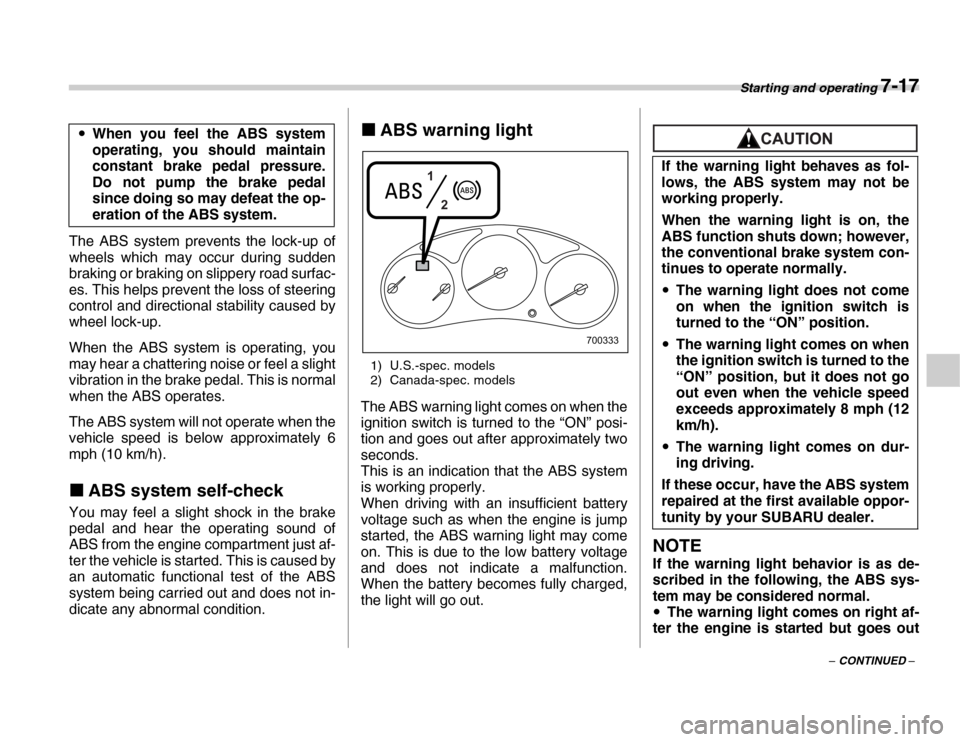
Starting and operating 7-17
– CONTINUED –
The ABS system prevents the lock-up of
wheels which may occur during sudden
braking or braking on slippery road surfac-
es. This helps prevent the loss of steering
control and directional stability caused by
wheel lock-up.
When the ABS system is operating, you
may hear a chattering noise or feel a slight
vibration in the brake pedal. This is normal
when the ABS operates.
The ABS system will not operate when the
vehicle speed is below approximately 6
mph (10 km/h). �„
ABS system self-check
You may feel a slight shock in the brake
pedal and hear the operating sound of
ABS from the engine compartment just af-
ter the vehicle is started. This is caused by
an automatic functional test of the ABS
system being carried out and does not in-
dicate any abnormal condition. �„
ABS warning light
1) U.S.-spec. models
2) Canada-spec. models
The ABS warning light comes on when the
ignition switch is turned to the “ON” posi-
tion and goes out after approximately two
seconds.
This is an indication that the ABS system
is working properly.
When driving with an insufficient battery
voltage such as when the engine is jump
started, the ABS warning light may come
on. This is due to the low battery voltage
and does not indicate a malfunction.
When the battery becomes fully charged,
the light will go out.
NOTE
If the warning light behavior is as de-
scribed in the following, the ABS sys-
tem may be considered normal. �y The warning light comes on right af-
ter the engine is started but goes out
�y
When you feel the ABS system
operating, you should maintain
constant brake pedal pressure.
Do not pump the brake pedal
since doing so may defeat the op-
eration of the ABS system.
1
2
700333 If the warning light behaves as fol-
lows, the ABS system may not be
working properly.
When the warning light is on, the
ABS function shuts down; however,
the conventional brake system con-
tinues to operate normally. �y
The warning light does not come
on when the ignition switch is
turned to the “ON” position.
�y The warning light comes on when
the ignition switch is turned to the
“ON” position, but it does not go
out even when the vehicle speed
exceeds approximately 8 mph (12
km/h).
�y The warning light comes on dur-
ing driving.
If these occur, have the ABS system
repaired at the first available oppor-
tunity by your SUBARU dealer.
Page 231 of 356
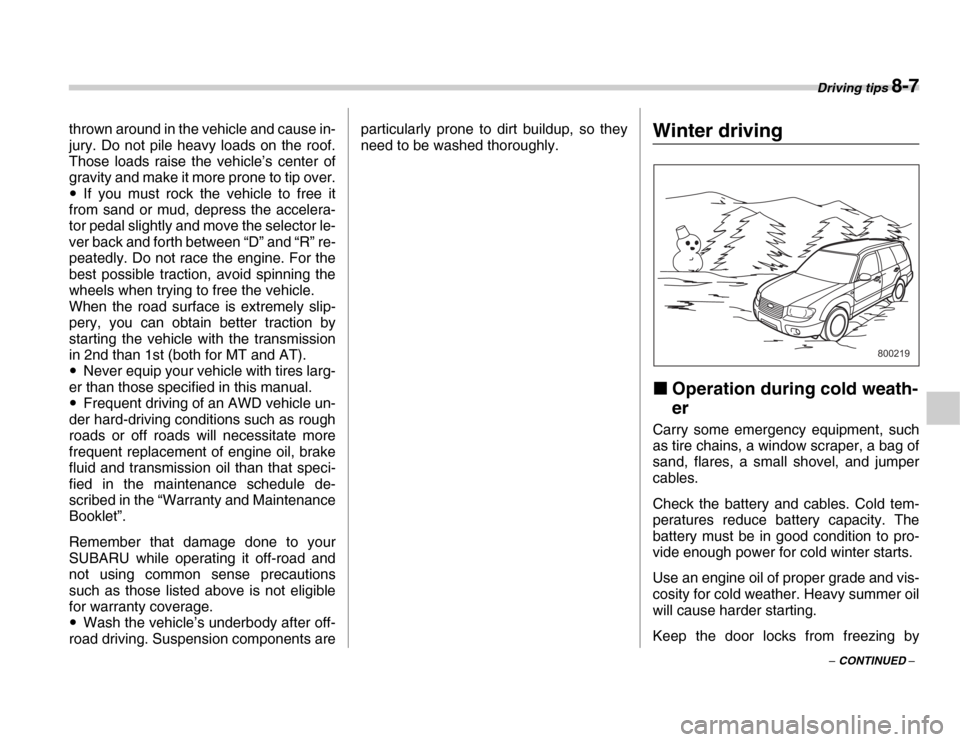
Driving tips 8-7
– CONTINUED –
thrown around in the vehicle and cause in-
jury. Do not pile heavy loads on the roof.
Those loads raise the vehicle’s center of
gravity and make it more prone to tip over. �y
If you must rock the vehicle to free it
from sand or mud, depress the accelera-
tor pedal slightly and move the selector le-
ver back and forth between “D” and “R” re-
peatedly. Do not race the engine. For the
best possible traction, avoid spinning the
wheels when trying to free the vehicle.
When the road surface is extremely slip-
pery, you can obtain better traction by
starting the vehicle with the transmission
in 2nd than 1st (both for MT and AT). �y Never equip your vehicle with tires larg-
er than those specified in this manual.�y Frequent driving of an AWD vehicle un-
der hard-driving conditions such as rough
roads or off roads will necessitate more
frequent replacement of engine oil, brake
fluid and transmission oil than that speci-
fied in the maintenance schedule de-
scribed in the “Warranty and Maintenance
Booklet”.
Remember that damage done to your
SUBARU while operating it off-road and
not using common sense precautions
such as those listed above is not eligible
for warranty coverage.�y Wash the vehicle’s underbody after off-
road driving. Suspension components are particularly prone to dirt buildup, so they
need to be washed thoroughly.
Winter driving �„
Operation during cold weath- er
Carry some emergency equipment, such
as tire chains, a window scraper, a bag of
sand, flares, a small shovel, and jumper
cables.
Check the battery and cables. Cold tem-
peratures reduce battery capacity. The
battery must be in good condition to pro-
vide enough power for cold winter starts.
Use an engine oil of proper grade and vis-
cosity for cold weather. Heavy summer oil
will cause harder starting.
Keep the door locks from freezing by
800219
Page 251 of 356

9
In case of emergency
If you park your vehicle in case of an emergency .................................................. 9-2
Temporary spare tire (if equipped) ................... 9-2
Flat tires .............................................................. 9-3 Changing a flat tire ................................................. 9-3
Jump starting ...................................................... 9-7 How to jump start ................................................... 9-8
Engine overheating ............................................ 9-10 If steam is coming from the engine compartment ......................................................... 9-10
If no steam is coming from the engine compartment ......................................................... 9-10
Towing ................................................................. 9-10 Towing and tie-down hooks .................................. 9-11
Using a flat-bed truck ............................................. 9-12
Towing with all wheels on the ground .................. 9-12
Rear gate – if the rear gate cannot be unlocked .......................................................... 9-13
Moonroof – if the moonroof cannot be closed ............................................................... 9-13
Maintenance tools .............................................. 9-14 Jack and jack handle .............................................. 9-14
Page 257 of 356
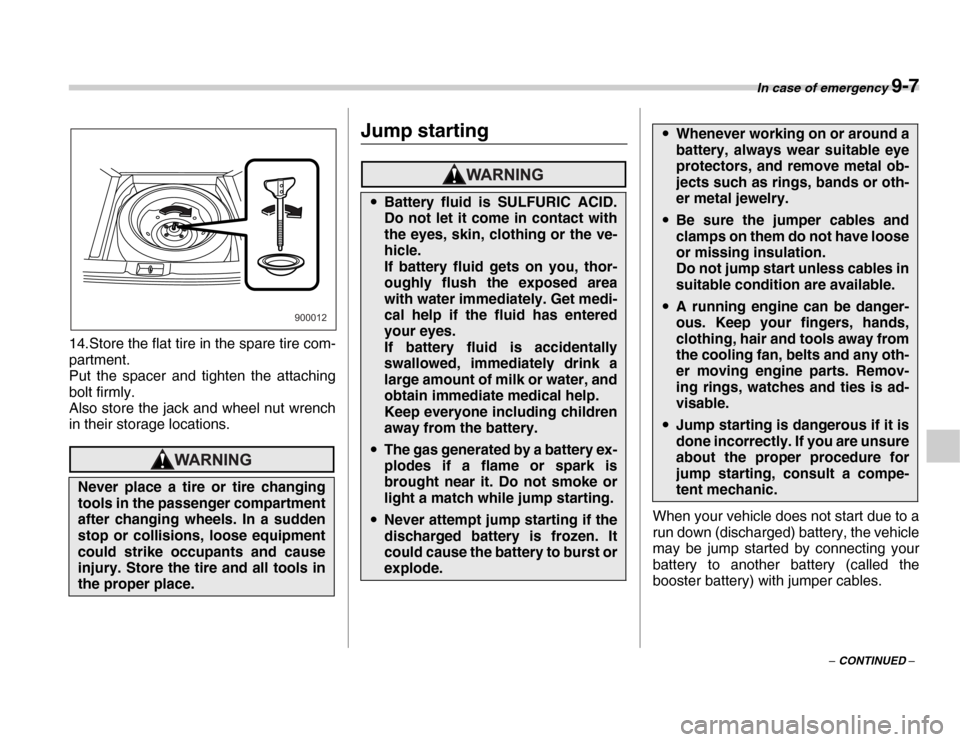
In case of emergency 9-7
– CONTINUED –
14.Store the flat tire in the spare tire com-
partment.
Put the spacer and tighten the attaching
bolt firmly.
Also store the jack and wheel nut wrench
in their storage locations.
Jump starting
When your vehicle does not start due to a
run down (discharged) battery, the vehicle
may be jump started by connecting your
battery to another battery (called the
booster battery) with jumper cables.
Never place a tire or tire changing
tools in the passenger compartment
after changing wheels. In a sudden
stop or collisions, loose equipment
could strike occupants and cause
injury. Store the tire and all tools in
the proper place.
900012
�y
Battery fluid is SULFURIC ACID.
Do not let it come in contact with
the eyes, skin, clothing or the ve-
hicle.
If battery fluid gets on you, thor-
oughly flush the exposed area
with water immediately. Get medi-
cal help if the fluid has entered
your eyes.
If battery fluid is accidentally
swallowed, immediately drink a
large amount of milk or water, and
obtain immediate medical help.
Keep everyone including children
away from the battery.
�yThe gas generated by a battery ex-
plodes if a flame or spark is
brought near it. Do not smoke or
light a match while jump starting.
�yNever attempt jump starting if the
discharged battery is frozen. It
could cause the battery to burst or
explode.
�yWhenever working on or around a
battery, always wear suitable eye
protectors, and remove metal ob-
jects such as rings, bands or oth-
er metal jewelry.
�yBe sure the jumper cables and
clamps on them do not have loose
or missing insulation.
Do not jump start unless cables in
suitable condition are available.
�yA running engine can be danger-
ous. Keep your fingers, hands,
clothing, hair and tools away from
the cooling fan, belts and any oth-
er moving engine parts. Remov-
ing rings, watches and ties is ad-
visable.
�yJump starting is dangerous if it is
done incorrectly. If you are unsure
about the proper procedure for
jump starting, consult a compe-
tent mechanic.
Page 258 of 356

9-8 In case of emergency
�„How to jump start
1. Make sure the booster battery is 12
volts and the negative terminal is ground- ed.
2. If the booster battery is in another vehi-
cle, do not let the two vehicles touch.
3. Turn off all unnecessary lights and ac-
cessories.
4. Connect the jumper cables exactly in
the sequence illustrated.
Page 259 of 356
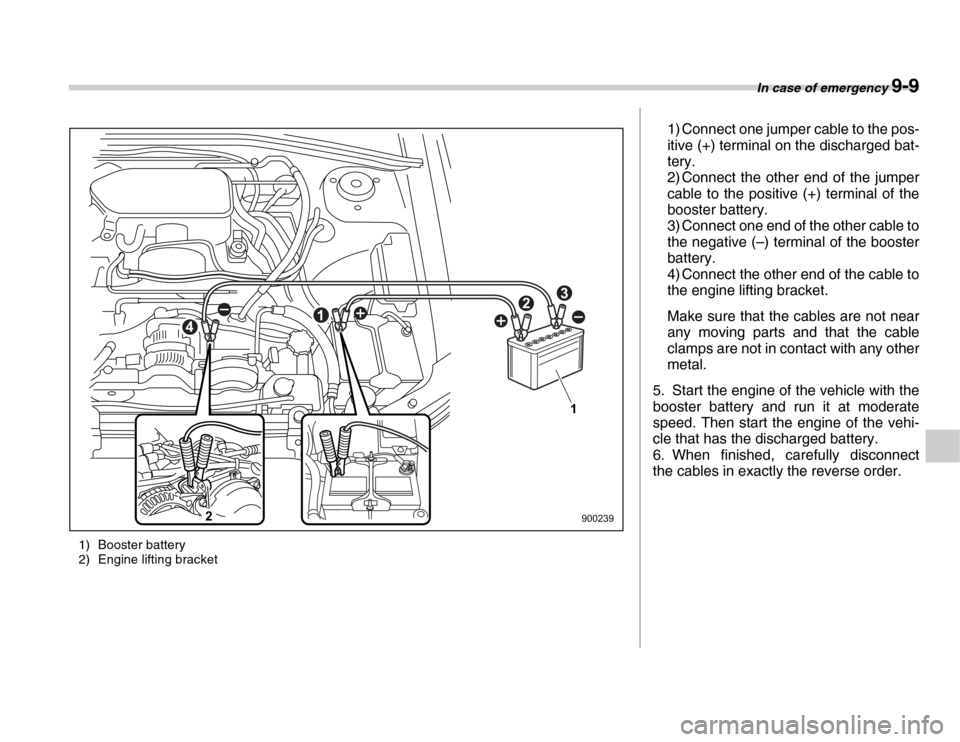
In case of emergency 9-9
1) Booster battery
2) Engine lifting bracket
12
1
2
3
4
900239 1) Connect one jumper cable to the pos-
itive (+) terminal on the discharged bat-
tery.
2) Connect the other end of the jumper
cable to the positive (+) terminal of the
booster battery.
3) Connect one end of the other cable to
the negative (–) terminal of the booster
battery.
4) Connect the other end of the cable to
the engine lifting bracket.
Make sure that the cables are not near
any moving parts and that the cable
clamps are not in contact with any other
metal.
5. Start the engine of the vehicle with the
booster battery and run it at moderate
speed. Then start the engine of the vehi-
cle that has the discharged battery.
6. When finished, carefully disconnect
the cables in exactly the reverse order.
Page 348 of 356

14-2 Index
A
ABS .................................................................................. 7-16Warning light ....................................................... 3-13, 7-17
Accessory power outlets .................................................... 6-8
Active head restraint ........................................................... 1-6
Air cleaner element ........................................................ 11-15
Air filtration system ........................................................... 4-12
Alarm system .................................................................... 2-12
All-Wheel Drive warning light (AT vehicles) ..................... 3-15
Aluminum wheel ............................................................. 11-35
Aluminum wheel cleaning ................................................. 10-3
Antenna system ................................................................. 5-2
Anti-lock brake system warning light (ABS) ............ 3-13, 7-16
Arming the system ............................................................ 2-13
Armrest ...................................................................... 1-10, 6-4
Ashtray (Canada only, if equipped) ......................... 6-11, 10-5
Audio set ............................................................................ 5-3
Auto-dimming mirror/compass ......................................... 3-26
Automatic climate control system ....................................... 4-8
Automatic transmission .................................................... 7-10
Capacities .................................................................... 12-4
Fluid ........................................................................... 11-20
Selector lever ............................................................... 7-11
Shift lock release ......................................................... 7-14
Temperature warning (AT OIL TEMP) ......................... 3-12
Automatic/Emergency Locking Retractor (A/ELR) ........... 1-12 B
Battery ............................................................................ 11-40 Jump starting ................................................................. 9-7
Replacing (remote keyless entry) .................................. 2-8 Brake
Booster ...................................................................... 11-27
Fluid ........................................................................... 11-25
Pad and lining ............................................................ 11-29
Parking ....................................................................... 11-30
Pedal .......................................................................... 11-27
System ......................................................................... 7-16
Warning light ................................................................ 3-13
Brake pedal .................................................................... 11-27 Free play .................................................................... 11-27
Reserve distance ....................................................... 11-27
Braking ............................................................................. 7-15
Braking tips ....................................................................... 7-15
Breaking-in of new brake pads and linings ..................... 11-29
Bulb Chart ............................................................................ 12-9
Replacing ................................................................... 11-44
C
Capacities ......................................................................... 12-4
Cargo area cover (if equipped) ......................................... 6-13
Cargo area light .................................................................. 6-2
Cargo tie-down hooks ....................................................... 6-14
Center console ................................................................... 6-4
Charge warning light ......................................................... 3-12
CHECK ENGINE warning light/Malfunction indicator lamp 3-11
Child restraint systems ..................................................... 1-24 Installation with seatbelt ............................................... 1-27
Top tether anchorages ................................................. 1-34
Child safety ............................................................................ 5
Child safety locks .............................................................. 2-17
Page 350 of 356

14-4 Index
Front seats ......................................................................... 1-2Fore and aft adjustment .......................................... 1-3, 1-4
Reclining ................................................................. 1-3, 1-5
Fuel .................................................................................... 7-2
Economy hints ............................................................... 8-2
Filler lid and cap ............................................................ 7-3
Requirements ................................................................ 7-2
Fuses ............................................................................. 11-41
Fuses and circuits ............................................................ 12-6 G
GAWR .............................................................................. 8-12
Glove box ........................................................................... 6-4
Gross Axle Weight Rating ................................................ 8-12
Gross Vehicle Weight Rating ........................................... 8-12
GVWR .............................................................................. 8-12 H
Hazard warning flasher ...................................................... 3-6
Head restraint adjustment .................................................. 1-6
Headlight Beam leveler ................................................................ 3-20
Flasher ........................................................................ 3-18
Headlights ........................................................................ 3-17
Heater operation ................................................................ 4-5
High beam indicator light .................................................. 3-15
Hill holder .............................................................. 7-21, 11-28
Horn ................................................................................. 3-29 I
Ignition switch ..................................................................... 3-3
Illuminated entry ................................................................. 2-8
Illumination brightness control .......................................... 3-19
Immobilizer indicator light ................................................... 2-3
Indicator light ...................................................................... 3-9
Inside mirror ...................................................................... 3-25
Interior lights ....................................................................... 6-2 J
Jack and jack handle ........................................................ 9-14
Jump starting ...................................................................... 9-7 K
Key
Number .......................................................................... 2-2
Reminder chime ............................................................. 3-5
Key interlock release (AT vehicles) .................................... 3-5
Keys .................................................................................... 2-2 L
Leather seat materials ...................................................... 10-5
Light control switch ........................................................... 3-17
Limited slip differential (LSD) ............................................ 7-15
Loading your vehicle ......................................................... 8-11
Low fuel warning light ....................................................... 3-14
Lower and tether anchorages ........................................... 1-32
LSD (Limited slip differential) ............................................ 7-15
Lumbar support (Drivers seat only) .................................... 1-5